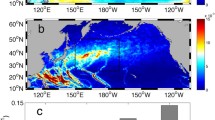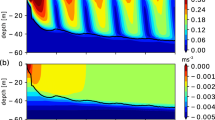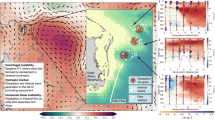Abstract
Upper-ocean turbulent mixing plays a vital role in mediating air-sea fluxes and determining mixed-layer properties, but its energy source, especially that near the base of the mixed layer, remains unclear. Here we report a potentially significant yet rarely discussed pathway to turbulent mixing in the convective mixed layer. During convection, as surface fluid drops rapidly in the form of convective plumes, intense turbulence kinetic energy (TKE) generated via surface processes such as wave breaking is advected downward, enhancing TKE and mixing through the layer. The related power, when integrated over the global ocean except near the surface where the direct effect of breaking waves dominates, is estimated at O (1)TW, comparable to that required by maintaining the Meridional Overturning Circulation (MOC). The mechanism in question therefore deserves greater research attention, especially in view of the potential significance of its proper representation in climate models.
Similar content being viewed by others
References
Anis A, Moum J N. 1994. Prescriptions for heat flux and entrainment rates in the upper ocean during convection. J. Phys. Oceanogr., 24 (10): 2 142–2 155.
Anis A, Moum J N. 1995. Surface wave–turbulence interactions. Scaling ε ( z ) near the sea surface. J. Phys. Oceanogr., 25 (9): 2 025–2 045.
Burchard H. 2002. Applied Turbulence Modelling in Marine Waters. Springer, Berlin Heidelberg, Germany. p.215.
Cerovečki I, Talley L D, Mazloff M R, Maze G. 2013. Subantarctic mode water formation, destruction, and export in the eddy-permitting Southern Ocean state estimate. J. Phys. Oceanogr., 43 (7): 1 485–1 511.
Craig P D, Banner M L. 1994. Modeling wave-enhanced turbulence in the ocean surface layer. J. Phys. Oceanogr., 24 (12): 2 546–2 559.
D’Asaro E A. 2014. Turbulence in the upper-ocean mixed layer. Annu. Rev. Mar. Sci., 6: 101–115.
de Boyer Montégut C, Madec G, Fischer A S, Lazar A, Iudicone D. 2004. Mixed layer depth over the global ocean: an examination of profile data and a profile-based climatology. J. Geophys. Res., 109 (C12): C12003, https://doi.org/10.1029/2004JC002378.
Endoh T, Matsuno T, Yoshikawa Y, Tsutsumi E. 2014. Estimates of the turbulent kinetic energy budget in the oceanic convective boundary layer. J. Oceanogr., 70 (1): 81–90.
Furuichi N, Hibiya T. 2015. Assessment of the upper-ocean mixed layer parameterizations using a large eddy simulation model. J. Geophys. Res., 120 (3): 2 350–2 369, https://doi.org/10.1002/2014JC010665.
Galperin B, Kantha L H, Hassid S, Rosati A. 1988. A quasiequilibrium turbulent energy model for geophysical flows. J. Atmos. Sci., 45 (1): 55–62.
Galperin B, Kantha L H, Mellor G L, Rosati A. 1989. Modeling rotating stratified turbulent flows with application to oceanic mixed layers. J. Phys. Oceanogr., 19 (7): 901–916.
Harcourt R R. 2013. A second-moment closure model of Langmuir turbulence. J. Phys. Oceanogr., 43 (4): 673–697.
Harcourt R R. 2015. An improved second-moment closure model of Langmuir turbulence. J. Phys. Oceanogr., 45 (1): 84–103.
Huang C J, Qiao F L. 2010. Wave-turbulence interaction and its induced mixing in the upper ocean. J. Geophys. Res., 115 (C4): C04026, https://doi.org/10.1029/2009JC005853.
Iudicone D, Madec G, Blanke B, Speich S. 2008. The role of Southern Ocean surface forcings and mixing in the global conveyor. J. Phys. Oceanogr., 38 (7): 1 377–1 400.
Kantha L, Tamura H, Miyazawa Y. 2014. Comment on “Waveturbulence interaction and its induced mixing in the upper ocean” by Huang and Qiao. J. Geophys. Res., 119 (2): 1 510–1 515, https://doi.org/10.1002/2013JC009318.
Langmuir I. 1938. Surface motion of water induced by wind. Science, 87 (2250): 119–123.
Leibovich S. 1980. On wave-current interaction theories of Langmuir circulations. J. Fluid Mech., 99 (4): 715–724.
Lenschow D H. 1974. Model of the height variation of the turbulence kinetic energy budget in the unstable planetary boundary layer. J. Atmos. Sci., 31 (2): 465–474.
Lombardo C P, Gregg M C. 1989. Similarity scaling of viscous and thermal dissipation in a convecting surface boundary layer. J. Geophy. Res., 94 (C5): 6 273–6 284.
Macdonald A M, Wunsch C. 1996. An estimate of global ocean circulation and heat fluxes. Nature, 382 (6590): 436–439.
Marshall J, Schott F. 1999. Open-ocean convection: observations, theory, and models. Rev. Geophys., 37 (1): 1–64.
McWilliams J C, Sullivan P P, Moeng C H. 1997. Langmuir turbulence in the ocean. J. Fluid Mech., 334: 1–30.
Mellor G L, Yamada T. 1974. A hierarchy of turbulence closure models for planetary boundary layers. J. Atmos. Sci., 31 (7): 1 791–1 806.
Mellor G L, Yamada T. 1982. Development of a turbulence closure model for geophysical fluid problems. Rev. Geophys., 20 (4): 851–875.
Mironov D V, Gryanik V M, Moeng C H, Olbers D J, Warncke T H. 2000. Vertical turbulence structure and secondmoment budgets in convection with rotation: a large-eddy simulation study. Quart. J. Roy. Meteor. Soc., 126 (563): 477–515.
Moeng C H, Sullivan P P. 1994. A comparison of shear- and buoyancy-driven planetary boundary layer flows. J. Atmos. Sci., 51 (7): 999–1 022.
Noh Y, Min H S, Raasch S. 2004. Large eddy simulation of the ocean mixed layer: the effects of wave breaking and Langmuir circulation. J. Phys. Oceanogr., 34 (4): 720–735.
Oka E, Qiu B. 2012. Progress of North Pacific mode water research in the past decade. J. Oceanogr., 68 (1): 5–20.
Osborn T R. 1980. Estimates of the local rate of vertical diffusion from dissipation measurements. J. Phys. Oceanogr., 10 (1): 83–89.
Sabine C L, Feely R A, Gruber N, Key R M, Lee K, Bullister J L, Wanninkhof R, Wong C S, Wallace D W R, Tilbrook B, Millero F J, Peng T H, Kozyr A, Ono T, Rios A F. 2004. The oceanic sink for anthropogenic CO2. Science, 305 (5682): 367–371.
Shay T J, Gregg M C. 1984. Turbulence in an oceanic convective mixed layer. Nature, 310 (5975): 282–285.
Siedler G, Church J, Gould J. 2001. Ocean Circulation and Climate: Observing and Modelling the Global Ocean. Academic Press, London. 715p.
Sloyan B M, Rintoul S R. 2001a. Circulation, renewal, and modification of Antarctic Mode and Intermediate Water. J. Phys. Oceanogr., 31 (4): 1 005–1 030.
Sloyan B M, Rintoul S R. 2001b. The Southern Ocean limb of the global deep overturning circulation. J. Phys. Oceanogr., 31 (1): 143–173.
Steffen E L, D’Asaro E A. 2002. Deep convection in the Labrador Sea as observed by Lagrangian floats. J. Phys. Oceanogr., 32 (2): 475–492.
Stull R B. 1988. An introduction to boundary layer meteorology. Kluwer, Dordrecht, The Netherlands, p.683.
Terray E A, Donelan M A, Agrawal Y C, Drennan W M, Kahma K K, Williams A J, Hwang P A, Kitaigorodskii S A. 1996. Estimates of kinetic energy dissipation under breaking waves. J. Phys. Oceanogr., 26 (5): 792–807.
Thorpe S A. 2004. Langmuir circulation. Annu. Rev. Fluid Mech., 36: 55–79.
Thorpe S A. 2005. The Turbulent Ocean. Cambridge University Press, Cambridge.
Wang W, Huang R X. 2004. Wind energy input to the surface waves. J. Phys. Oceanogr., 34 (5): 1 276–1 280.
Wunsch C, Ferrari R. 2004. Vertical mixing, energy, and the general circulation of the oceans. Annu. Rev. Fluid. Mech., 36: 281–314.
Acknowledgement
The authors would like to thank the anonymous reviewers for their valuable suggestions.
Author information
Authors and Affiliations
Corresponding author
Additional information
Supported by the National Basic Research Program of China (973 Program) (No. 2015CB954300), the AoShan Talents Program Supported by Qingdao National Laboratory for Marine Science and Technology (No. 2015ASTP-OS02), and the National Natural Science Foundation of China (No. 41376011)
Rights and permissions
About this article
Cite this article
Zhang, Y., Wang, W. Convection: a neglected pathway for downward transfer of wind energy in the oceanic mixed layer. J. Ocean. Limnol. 36, 1189–1197 (2018). https://doi.org/10.1007/s00343-018-7081-1
Received:
Accepted:
Published:
Issue Date:
DOI: https://doi.org/10.1007/s00343-018-7081-1




